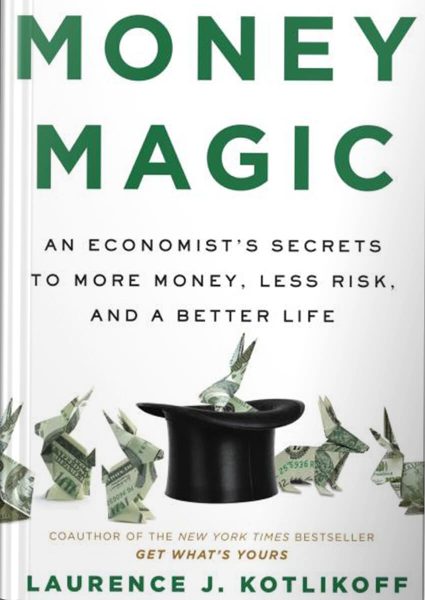Most people are really bad at personal financial planning. Among the mistakes: they save too little or they save too much; they buy the wrong amount of life insurance; they leave great sums of Social Security benefits on the table; they pay more in taxes than they should, etc.
The people who make these mistakes are not just ordinary folks. They include highly educated, sophisticated people – including virtually all economists and Wall Street analysts. They almost certainly include you, the reader.
So why do so many people get so many things wrong? Because financial planning is very, very complicated. To pick one example, Social Security has 2,728 rules governing 13 benefits. And the agency is unforgiving. It doesn’t give you money back once you discover a past mistakes.

Because financial planning is so difficult, most people make really important decisions without knowing the true costs of their choices. Getting married, getting divorced, deciding to have another child, quitting work to go back to school, retiring early, etc. These aren’t small decisions.
Fortunately, help is at hand. Boston University professor Laurence Kotlikoff has written Money Magic, a must-read book that has valuable information for just about everybody. The book itself goes through the major mistakes people make that limit their income, increase their taxes, or subject them to unnecessary risk.
Take Social Security. Americans leave billions of dollars on the table every year because they don’t claim benefits in the most advantageous way. Kotlikoff says it’s a “use it or lose it” system. If you don’t formally request a benefit to which you are entitled you won’t get it.
People sacrifice billions more – not because of mistakes, but because they don’t make smart choices. For example, unless you are terminally ill it’s almost always a bad idea to claim early Social Security benefits. If you wait until age 70, you will miss out on 8 years of benefit checks. But Social Security more than makes up for that by increasing your monthly benefit amount by 8 percent for every year you delay.
Roughly speaking, 5 percent of that increase makes up for the years of not receiving benefits, and the remaining 3 percent can be thought of as a real return on your “Social Security wealth.” Where else can you find an asset that pays a risk-free, 3 percent real rate of return?
If at all possible, Kotlikoff advises, live on withdrawals from your IRA or your 401(k) account and let your Social Security account grow.
Another big-ticket item in most people’s financial life is housing. In fact, the average family spends 25 percent of its disposable income on it.
Most people think of the cost of housing as their mortgage payment. But that’s wrong, says Kotlikoff. The cost of your house is the price you pay for it. If you take out a mortgage, that’s a separate decision, and one that you should avoid if possible. “Mortgages are not your friend,” he writes. “They are tax and financial losers, [so] pay them off as quickly as possible.”
Here’s why. The interest rate on a typical 30-year mortgage is more than twice the rate on 30-year government bonds. Both rates are fixed. So, if you take out a big mortgage so that you can invest in financial assets, you’re losing money.
What about maintaining a mortgage so you can invest in the stock market? Over the long haul, stocks do pay more than bonds. But that’s because they are riskier. After adjusting for risk, the rate of return is the same. “Holding a mortgage . . . while investing at risk is borrowing to gamble,” he writes.
But aren’t mortgage payments tax deductible? This use to be an attraction. Tax reform in 2017, however, raised the standard deduction so high that most households get no benefit from mortgage deductions. Kotlikoff even encourages people to consider taking money out of a regular IRA or Roth IRA to pay off their mortgage.
So why own a house at all? Why not rent? Turns out there is a tax advantage to home ownership. Take two identical people who own two identical houses. But instead of living in the house they own, each lives in the other’s house and pays a market rent. The result: their rental income gets taxed. But if each lives in her own home, the rental value of home ownership is tax free. That’s a tax advantage you don’t get from owning any other asset.
Then, there is the scandal of student loans. After mortgages, student loans totaling more than $1.6 trillion are our largest form of debt. And it’s risky debt. Two in five students drop out of college and never graduate. Those that do graduate face an average debt of $33,000. Some owe more than $100,000. Parents also accumulate debt for their college-bound children, which now totals around $100 billion. In 2019, one in five borrowers were unable to pay what they owed.
A Kotlikoff chapter on this issue is titled, “Don’t Borrow for College – It’s Way too Risky.” Every high school student headed for college and every parent of these students needs to read this chapter, and read it several times.
About 90 percent of student loans are federal government loans. If you can’t repay them, you can’t discharge them with ordinary bankruptcy. The government can garnish your wages. It can seize part of your Social Security check. You may not be able to renew a professional license or enlist in the armed forces.
Kotlikoff blames colleges for charging a full freight of $80,000 a year for tuition, room and board, or $320,00 over four years, and enticing entrants with loans they call “awards.” He compares this to the sharecropper system prevalent in the postbellum South, in which “students borrowing for college are the sharecroppers and the landlords are Uncle Sam and his higher education compadres.”
There are many good suggestions on how parents can rearrange their financial portfolios in order to qualify for (non-loan) student aid, and brilliant suggestions on how students can in enroll in inexpensive colleges and take online courses from elite schools like Harvard and Yale.
As a bonus, Kotlikoff invites you to take advantage of his online software package that sorts though all kinds of complicated issues that no human mind is able to master on its own.
If you don’t save more than the price of this book, there is something seriously wrong with you.
Purchase Money Magic on Amazon.com

0 Comments